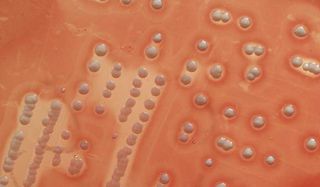Staph Bacteria in Household Boosts Infection Risk

Family members of children who have staph infections are more likely than other people to carry drug-resistant versions of the bacteria, even though they may not have any symptoms of infection, a new study suggests.
The researchers looked at 609 family members of 183 children infected with Staphylococcus aureus (S. aureus) bacteria, and found that 53 percent — all who lived with the infected child — also carried staph bacteria.
Between 25 and 30 percent of people in the general population carry staph bacteria, typically in the nose, without symptoms, according to the Centers for Disease Control and Prevention (CDC).
Results also showed that 19 percent of family members carried MRSA, a strain of staph bacteria that is particularly difficult to treat due to its resistance to antibiotics, 32 percent hosted methicillin-sensitive S. aureus (MSSA), a strain that responds to antibiotics, and 2 percent carried both MRSA and MSSA.
Around 1 percent of the general population carries MRSA, according to the CDC.
“Failure to identify all colonized household members may result in persistent colonization or recurrent infections," said study researcher Dr. Stephanie Fritz, an assistant professor of pediatrics at Washington University School of Medicine in St. Louis.
The children in the study were being treated for staph infections of the skin or soft tissues — around the nose, armpits or groin, for example, with the groin being the most common point of infection. Sixty-one percent of the children were infected with MRSA, 30 percent with MSSA and 9 percent with both.
Sign up for the Live Science daily newsletter now
Get the world’s most fascinating discoveries delivered straight to your inbox.
Staph infections spread via close contact and the sharing of certain items, such as towels or razors, which are potential reservoirs of staph bacteria, Fritz said. People can spread the bacteria even if they don't experience any symptoms. Symptoms of staph infections include minor sores or a rash on the skin, and fever. If the bacteria reach the heart or brain, they can cause severe health problems.
The children in the study ranged in age from 6 months to 20 years old. Family members were included in the study if they said they spent more than half their time living in the same house as the infected child.
The researchers also found that parents were slightly more likely to host a MRSA staph infection than siblings.
In order to reduce the spread of staph infections, the researchers suggested practicing good hygiene, limiting the sharing of intimate objects such as bath towels, cleaning wounds properly and wiping down surfaces that are often touched with bare skin.
The researchers said they will next study more specifically how the germs are spread within a household, in hopes of understanding how to limit infection.
The research was published today (June 4) in the Archives of Pediatrics & Adolescent Medicine.
Pass it on: Family members of children carrying staph infections are more likely than the general population to carry the infection without suffering its symptoms, which may contribute to perpetuated infection.
Follow MyHealthNewsDaily on Twitter @MyHealth_MHND. Find us on Facebook.

